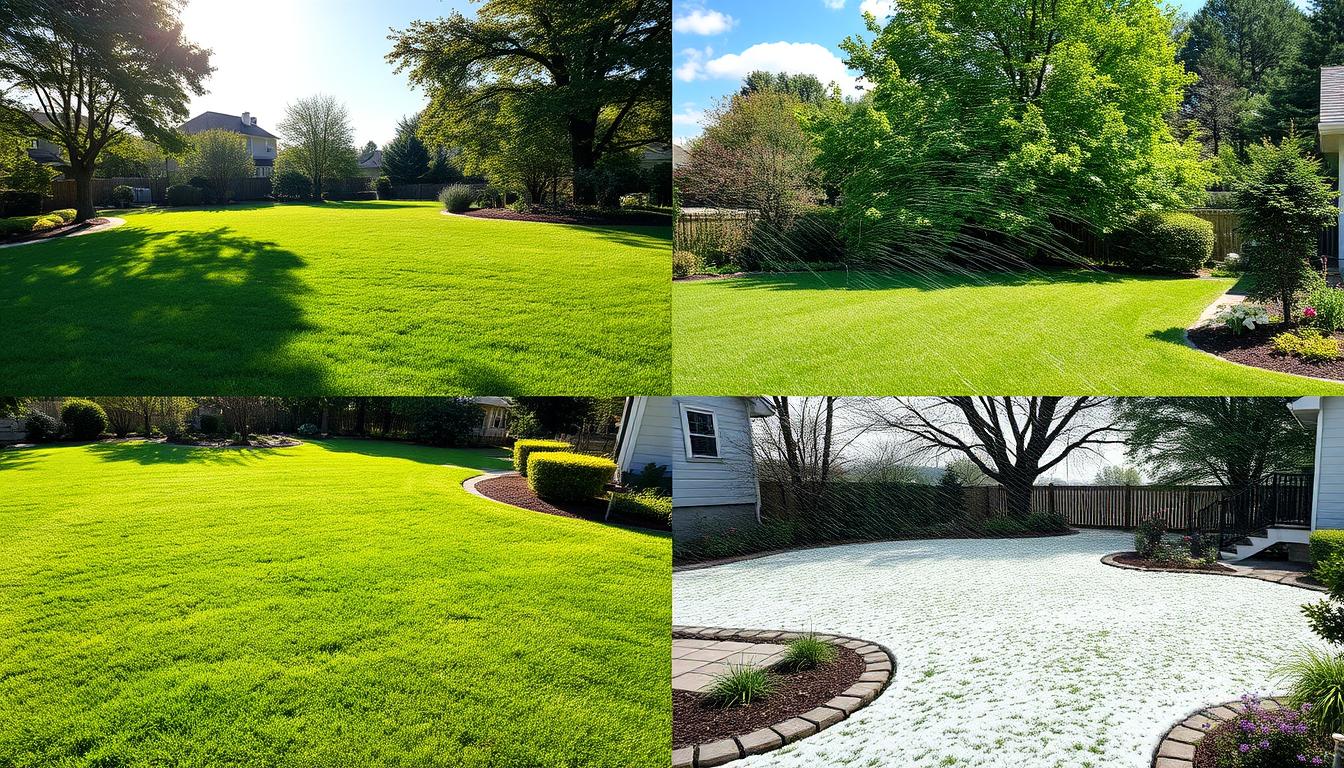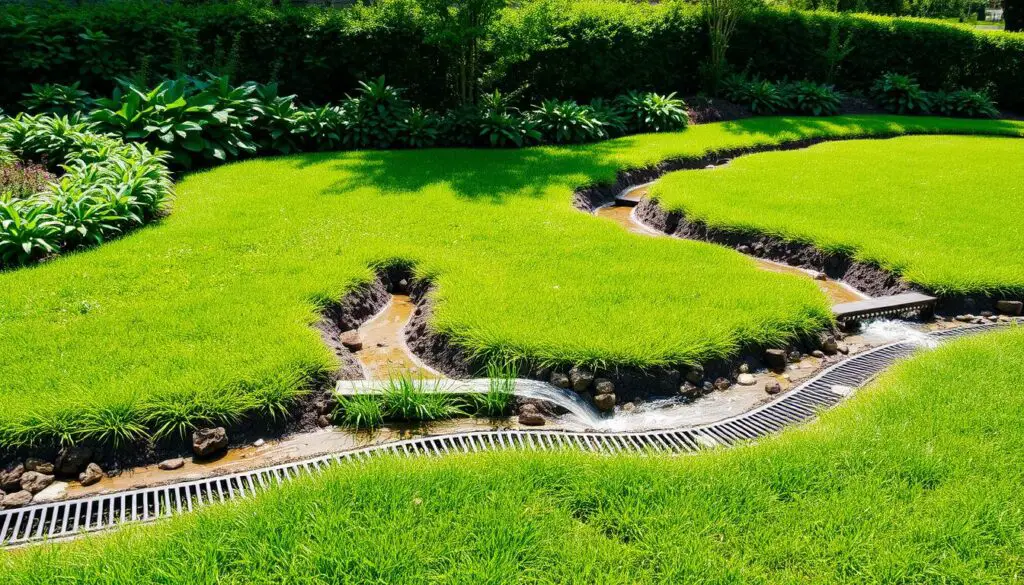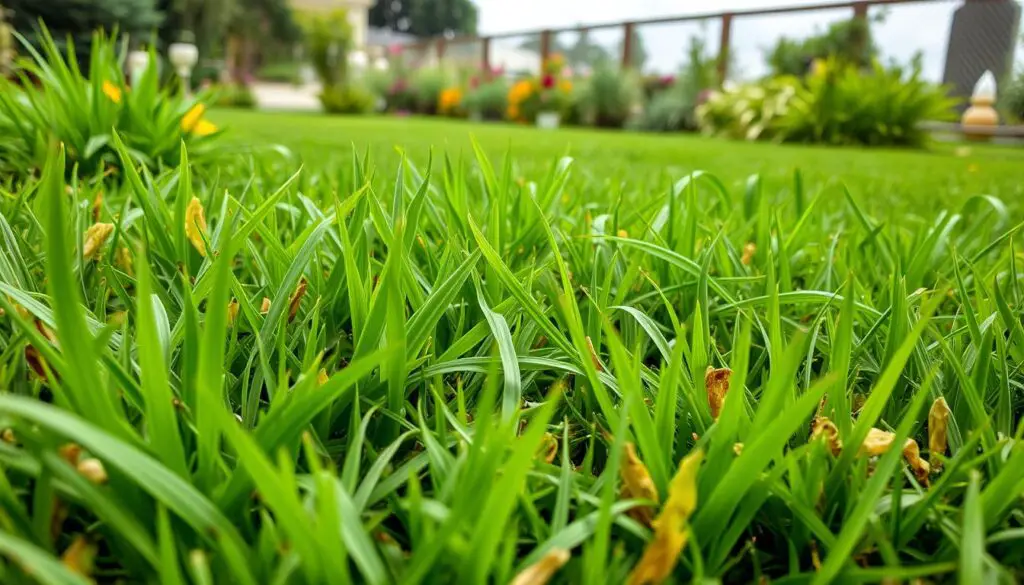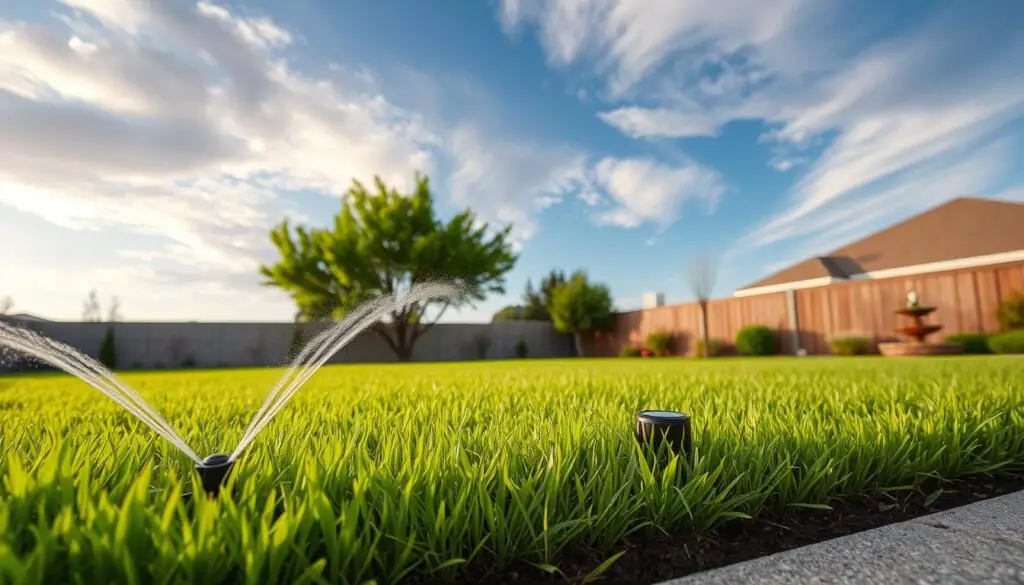The Top Bad Weather Lawn Care Tips

Did you know Turf Unlimited has helped over 3,000 satisfied clients since 1996? Their secret? They know how weather affects lawn health. They handle everything from summer heat to winter frost, keeping lawns green all year.
Rain, snow, or heatwaves—learn the best bad weather lawn care tips to keep your grass green.
As someone who loves lawn care, I’ve learned weather plays a big role. Warmer winters mean more pests, while heavy rain can harm soil. Tailored lawn care for the weather helps prevent diseases and keeps grass healthy.
In this article, we’ll look at how weather affects your lawn. We’ll share tips to help you adjust your lawn care for the best results. By understanding weather challenges, you can keep your lawn looking great all season.
Key Takeaways
Unexpected storms can harm your lawn. Use these bad weather lawn care tips for year-round health.
- Weather conditions significantly impact the health and appearance of your lawn.
- Adapting lawn care practices to seasonal weather patterns is crucial for maintaining a lush, vibrant lawn.
- Proper timing of mowing and lawn can help your grass thrive in various weather conditions.
- Incorporating drought-resistant grasses and efficient watering systems can help your lawn withstand periods of heat and low rainfall.
- Understanding the unique weather challenges in your area, such as frost, humidity, or strong winds, will enable you to develop a tailored lawn care strategy.
Sunshine and Heat: Friends or Foes?
The warm summer sun is important for our lawn. It helps grass grow and do photosynthesis. But too much heat and dryness can turn our lawn into dry, yellow spots.
Adapting to Excessive Heat and Dehydration
High temperatures dry out the soil fast. This makes grass more likely to get sick and attract pests. To fight this, choose drought-tolerant grass varieties like tall fescue. It only needs half an inch of water a week to stay healthy.
Using lawn irrigation practices wisely also helps. Watering in the early morning helps keep water from evaporating too fast.
Providing Shade and Optimizing Photosynthesis
While the sun is warm, too much can harm. Trees or shade structures can protect your lawn from the sun. This keeps it 4°C cooler than urban surfaces not covered with turf.
This not only looks better but also helps grass photosynthesize well. This keeps your lawn lush and healthy all summer.
| Grass Variety | Drought Tolerance | Sun Exposure Preference |
|---|---|---|
| Tall Fescue | High | Full Sun |
| Bermuda Grass | Moderate | Full Sun |
| Zoysiagrass | High | Full Sun |
| Centipedegrass | Moderate | Partial Shade |
| St. Augustinegrass | Moderate | Partial Shade |
By balancing sunshine, heat, and water, you can make your lawn thrive. Even in the hottest summer months.
“Turfgrass can be as much as 39°C cooler than synthetic turf on a hot day.” – Sam, lawn specialist
Rainfall: The Double-Edged Sword
Water is key for a healthy lawn, and rain provides it. But too much rain can harm your lawn. It can make the soil soggy, hurting the roots and causing diseases.
Not enough rain can also be a problem. It can make your lawn dry and look bad. To fix these issues, you need good lawn drainage and water-saving systems. Also, using drought-resistant plants is important.
Managing Waterlogged Lawns and Drainage
Dealing with a waterlogged lawn is tough. It’s perfect for fungi and can choke the roots. To solve this, improve your lawn’s drainage.
You can use drainage pipes, French drains, or natural methods. Sloping your lawn can help move water away.
Preventing Drought Stress and Conserving Water
Drought can make your lawn look bad and weak. To avoid this, pick drought-resistant plants and use water-saving irrigation. These steps keep your lawn green and save water.
| Lawn Drainage Solutions | Drought-Resistant Landscaping | Water-Saving Irrigation Systems |
|---|---|---|
| Drainage pipes | Drought-tolerant grass varieties | Drip irrigation |
| French drains | Native and adaptive plant species | Smart sprinkler controllers |
| Natural slope management | Xeriscaping techniques | Rainwater harvesting systems |

Using these methods helps your lawn stay healthy, no matter the weather. It keeps your lawn looking great all year.
Winter Weather Wonders: Frost, Snow, and Lawn Protection
When the snow starts falling, our lawns face new challenges. Frost can harm plants by freezing water in their cells. But, snow can protect the grass by keeping it warm.
But, snow can also be a problem. It can make the lawn hard to breathe, hurting the roots. To keep your lawn healthy, aerate the soil before the frost. Watch for damage or pests to fix problems fast.
Our lawns are important, for looks and for the environment. They can increase property value and clean the air. By understanding how to protect them from frost and snow, we can keep them looking great.
The winter can be tough on our lawns, with footprints and snow mold. But, with some planning and care, we can keep our lawns looking good. They’ll be ready to show off when spring comes.
| Winter Lawn Issue | Cause |
|---|---|
| Footprints | Cold weather causes grass cells to freeze, leading to shattered cells and dead spots resembling footprints. |
| Snow Mold | Moist conditions under snow blankets create ideal environments for snow mold growth, leading to brown patches in grass. |
| Fungus | Fungus thrives in moist winter settings, causing disease, discoloration, and spot formation in grass. |
| Voles | Rodents called voles create trails through lawns beneath snow cover, leaving dead grass in their paths. |
Humidity: The Moisture Factor for Fungal Growth
In the Midwest, keeping your lawn healthy is a big challenge. The humid climate is perfect for fungi like mold and mildew. These fungi can cause diseases like dollar spot and brown patch.
To fight these fungi, understanding humidity’s role is key. Too much moisture in the air means more spores. This creates a perfect environment for fungi to grow. Managing humidity and air flow are essential to stop these diseases.
Combating Humidity-Driven Fungal Diseases
Improving air flow around your lawn is a great way to fight fungal diseases. You can do this by mowing in patterns, designing your landscape, and placing trees and shrubs wisely. This helps prevent fungi from growing, keeping your lawn healthy.

It’s also important to keep soil moisture right. Too much water feeds fungi, while too little stresses the grass. Finding the perfect balance is crucial for lawn fungal disease prevention.
“Proper humidity management and air circulation are the cornerstones of a healthy, fungus-free lawn in the Midwest.” – Sam, author of the Mowers Guide
By being careful and using the right methods, you can keep your lawn healthy. Even with high humidity and fungal threats, a dedicated approach can lead to a lush lawn. With the right humidity management strategies, your lawn will thrive all season.
Wind: More Than Just a Breeze for Soil Erosion
Wind is more than just a gentle breeze. It can strip away topsoil and nutrients, leading to wind erosion control issues. It also increases evapotranspiration management, drying out the soil. Yet, gentle winds can help by improving air flow optimization, reducing fungal infections.
Mitigating Wind Damage and Evaporation
To fight wind damage, use wind barriers like shrubs or fences. They protect your lawn from erosion and moisture loss. Adjusting your watering schedule can also help manage evaporation.
Leveraging Gentle Breezes for Air Circulation
Gentle breezes are good for your lawn. They improve air flow optimization, fighting fungal diseases. Place your outdoor furniture to catch these breezes and keep your lawn healthy.
| Benefit | Impact |
|---|---|
| Wind Erosion Control | Preventing the loss of vital topsoil and nutrients |
| Evapotranspiration Management | Reducing excessive moisture loss from the soil |
| Air Flow Optimization | Promoting air circulation to combat fungal diseases |
Understanding wind’s effects on your lawn helps you take action. Strategic measures can keep your lawn healthy, no matter the wind.
“The wind is a powerful force, both for good and ill. By learning to harness its benefits and protect against its drawbacks, we can create a lush, resilient lawn that thrives in any breeze.” – Sam, lawn expert
Extreme Weather Events: Preparing for the Worst
As a lawn lover, I’ve seen how extreme weather can hurt our lawns. Hurricanes and storms cause flooding and soil erosion. Droughts stress the grass. These disasters can destroy our hard work.
But, we can prepare to lessen the damage. Improving our drainage systems helps with waterlogged lawns. Choosing grass that can handle drought is also smart. And having plans for quick recovery from weather disasters is key.
The National Weather Service says flooding is the deadliest severe weather. It’s surprising that 25% of flood insurance claims are in low-to-moderate risk areas. That’s why every family should have a Storm Readiness Kit for 48 hours without power.
There are also more detailed storm kits for longer stays (three to four days and one week). Filling containers with water for hygiene is wise. And having a kit in your car can save lives during storms.

For hurricane safety, strong roofs and reinforced garage doors are essential. Caulking to keep rain out is cheap and effective. If a tornado hits, seek shelter in basements or the lowest part of your home.
By being proactive in lawn disaster preparedness, hurricane and drought recovery, and soil erosion prevention, we protect our lawns and homes. It’s worth it for the peace of mind knowing our lawns are ready for extreme weather.
Lawn Care Weather Tips: Tailoring Practices to Microclimates
Keeping your lawn healthy starts with knowing your local microclimate. Microclimates are small areas with their own climate. Things like buildings, trees, and water can change the climate in your yard.
Understanding your lawn’s microclimate helps you care for it better. For example, shady spots might need less water but could get fungal diseases. Sunny areas, on the other hand, might need more water and grass that can handle the sun.
To make your lawn the best it can be, follow these microclimate identification, location-specific lawn care, and site-specific maintenance tips:
- Watch your lawn closely for differences in moisture, sunlight, and growth.
- Get your soil tested to see what nutrients and pH levels it needs. These can change in different parts of your lawn.
- Change how you mow, water, and fertilize based on each area’s needs.
- Pick grass and plants that fit each microclimate’s conditions. This means choosing ones that can handle drought or shade.
- Use trees, shrubs, and shade structures to create good microclimates and make your lawn stronger.
By understanding and adjusting to your lawn’s microclimates, you can make sure each area gets the care it needs. This leads to a lawn that looks great, is healthy, and can handle the weather.
“Tailoring your lawn care to the unique microclimates within your property is the key to a lush, resilient, and visually stunning landscape.” – Fin, Mowers Guide follower
Leveraging Technology for Weather-Responsive Lawn Care
Smart lawn technology has made caring for your yard easier and more effective. Now, data-driven irrigation systems adjust watering based on the weather. This ensures your lawn gets just the right amount of moisture.
Soil sensors also help by checking moisture and nutrient levels. They give insights for timely lawn care.
Mobile lawn care apps have also changed the game. They help spot lawn problems and suggest fixes. This lets you manage your yard better, no matter the weather.
Smart Irrigation Systems and Real-Time Data
Smart irrigation systems are a big deal in lawn care. They use weather data to adjust watering. This means your lawn gets the right amount of water, avoiding waste.
By doing this, you help your grass grow well and save water. It’s good for the environment too.
Mobile Apps for Problem Identification and Remedies
Mobile lawn care apps are great for homeowners. They use images to spot lawn problems like diseases or pests. Then, they offer specific advice on how to fix them.
With these apps, keeping your lawn healthy and weather-ready is easy. Just use your phone.
| Technology | Benefits |
|---|---|
| Smart Irrigation Systems |
|
| Mobile Lawn Care Apps |
|
Smart lawn technology and data-driven solutions can take your lawn care to the next level. They help your outdoor space thrive, no matter the weather. With these tools, you can optimize irrigation and solve lawn problems easily.

Seasonal Lawn Care Adjustments for Optimal Health
Living in the United States, I’ve learned how seasons affect my lawn. Each season has its own weather, and knowing this helps me care for my lawn better. I adjust how I mow, fertilize, and water to keep my lawn looking great all year.
In spring, I use fertilizers rich in nitrogen to help my grass grow. When summer gets hot and dry, I raise my mower to help my grass stay cool and moist. In fall, I use a fertilizer high in potassium to strengthen my lawn for winter.
By keeping up with seasonal lawn care, my lawn stays healthy and strong. It’s a lot of work, but it’s worth it for a beautiful outdoor space all year.
FAQ
How does sunshine and heat affect my lawn?
How does rainfall impact my lawn’s health?
How does winter weather affect my lawn?
How does humidity impact my lawn’s health?
How does wind affect my lawn?
How can I prepare my lawn for extreme weather events?
How can I account for microclimates when caring for my lawn?
How can technology help me manage my lawn in response to changing weather patterns?
How can I adjust my seasonal lawn care practices to optimize lawn health?
Source Links
- https://www.turfunlimited.com/2023/11/03/the-impact-of-climate-change-on-lawn-care-and-landscaping/
- https://www.weathershack.com/blogs/news/how-to-use-weather-data-for-efficient-lawn-care?srsltid=AfmBOoqY-Fkr3VVH9KAA2_EQTD-Fo3vO33jA9P6Ekpt7tO1VERvq7qW_
- https://extension.oregonstate.edu/gardening/lawn/through-thoughtful-practices-lawns-can-be-climate-friendly
- https://southernstatelandscape.com/cut-grass-essentials-tips-and-tricks-for-a-perfect-lawn/
- https://www.bbc.co.uk/gardening/basics/weather_climatewarming.shtml
- https://lawnscience.com/why-spring-reseeding-is-overrated-and-costly/
- https://www.rlminc.com/blog/how-to-prepare-your-lawn-for-winter/
- https://www.rossenlandscape.com/blog/preparing-your-lawn-for-winter-a-seasonal-checklist
- https://earth-smart.ca/winter-wonders-10-surprising-facts-about-your-lawn-and-grass/
- https://perma-green.com/lawn-fungus-northwest-indianas-extreme-humidity-causes-grass-disease/
- https://www.naturalgreenlawnandpest.com/blog/turf-disease-facts-how-lawn-fungus-control-works
- https://www.gogreenstripe.com/pests-problems/how-to-treat-lawn-fungus
- https://cleanimagerestoration.com/what-are-the-damaging-effects-of-the-wind/
- https://www.canr.msu.edu/news/wind_is_essential_to_natural_processes
- https://education.nationalgeographic.org/resource/wind/
- https://www.familyhandyman.com/list/81-severe-weather-survival-tips-every-homeowner-must-know/
- https://www.lawnmoregainesville.com/blog/prepare-yard-for-hurricane
- https://rainscapes.com/identifying-and-managing-common-lawn-diseases-through-effective-irrigation-and-maintenance/
- https://relslandscaping.com/keep-your-landscaping-vibrant-in-the-summer-heat/
- https://sites.utexas.edu/discovery/2024/07/17/how-weather-patterns-affect-lawn-health/
- https://www.serviceautopilot.com/lawn-care/the-5-hottest-upcoming-lawn-care-industry-trends-of-2024/
- https://www.tenato.com/blog/the-forecast-on-weather-marketing/
- https://www.zuper.co/blog/guide-to-seasonal-lawn-maintenance-schedule
- https://nexgreen.com/adapting-lawn-care-across-seasons-tips-from-nexgreen-experts/

